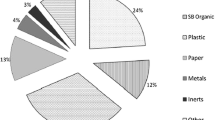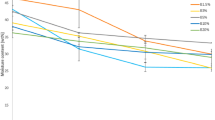Abstract
This study aimed to identify possibilities to improve the quality of the stabilized biowaste coming from the mechanical–biological treatment of municipal solid waste produced in Rome for possible recovery rather than landfilling. The waste sampled before and after the first and the fourth week of aerobic biodegradation as well as different particle size classes composing the biostabilized materials were characterized in order to investigate the content and distribution of contaminants. Results showed, firstly, that the stabilized biowaste was not biologically stable after 4 weeks of biostabilization process, presenting dynamic respiration index >1,000 mg O2 kg VS−1 h−1. Heavy metal (Cd, Cr, Cu, Ni, Pb, Zn) content fulfilled the requirements for utilization, but by contrast, their release in water phase was quite high and not complying with Italian regulatory limits for waste recovery. In order to raise the quality, the biological process management should be improved by increasing the water amount to add to the rotting waste since the output material had moisture (19.7 % WM) lower than the recommended content for an optimized aerobic biodegradation (>40 %). Furthermore, fractions having particle size higher than 10 mm, composed of high content of impurities and heavy metals, should be separated by obtaining a reduction in chemical–physical contamination. Finer waste flow (<10 mm) can be recovered in environmental remediation activities, whereas coarser fractions (>10 mm) can be used in waste-to-energy plants, given the great content of high calorific value materials and the compliance with characteristics defined for solid recovered fuels.





Similar content being viewed by others
References
ACO (2001) Verordnung des Bundesministers für Land- und Forstwirtschaft, Umwelt und Wasserwirtschaft über Qualitätsanforderungen an Komposte aus Abfällen (Kompostverordnung). Verordnung nr 292, emitted 14 August 2001
Adani F, Confalonieri R, Tambone F (2004) Dynamic respiration index as a descriptor of the biological stability of organic wastes. J Environ Qual 33:1866–1876
Amir S, Hafidi M, Merlina G, Revel JC (2005) Sequential extraction of heavy metals during composting of sewage sludge. Chemosphere 59:801–810
Angermeier R, Tintner J, Smidt E, Ottner R, Matiasch L, Binner E, Böhm K (2011) Development of mechanically biologically treated municipal solid waste under different vegetation types. J Environ Eng 137(5):340–346
ASTM (2007) Standard test method for particle-size analysis of soils. ASTM Standard D422-63, ASTM International, West Conshohocken, PA. doi:10.1520/D0422-63R07
Baird J, Hutton M, Savage A, Hipkin A, Cruz P, MacLeod I (2005) The use of stabilised biowaste in the restoration of former landfill sites. Environment Group Research Report 2005/03, Scottish Executive, Edinburgh, UK
Barrena R, D’Imporzano G, Ponsá S, Gea T, Artola A, Vázquez F, Sánchez A, Adani F (2009) In search of a reliable technique for the determination of the biological stability of the organic matter in the mechanical–biological treated waste. J Hazard Mater 162(2–3):1065–1072
Bayard R, de Araújo Morais J, Ducom G, Achour F, Rouez M, Gourdon R (2010) Assessment of the effectiveness of an industrial unit of mechanical–biological treatment of municipal solid waste. J Hazard Mater 175(1–3):23–32
Binner E, Böhm K, Lechner P (2012) Large scale study on measurement of respiration activity (AT4) by Sapromat and OxiTop. Waste Manag 32(10):1752–1759
Castaldi P, Santona L, Melis P (2006) Evolution of heavy metals mobility during municipal solid waste composting. Fresenius Environ Bull 15(9b):1133–1140
DEFRA (Department for Environment Food and Rural Affairs) (2013) Mechanical biological treatment of municipal solid waste. http://www.defra.gov.uk/publications/. Accessed 21 July 2014
Di Lonardo MC (2013) Evaluations for a possible recovery/utilisation of mechanically–biologically treated municipal solid waste by means of different operating conditions and retaining times. Dissertation, University of Rome “Tor Vergata”
Di Lonardo MC, Lombardi F, Gavasci R (2012a) Characterization of MBT plants input and outputs: a review. Rev Environ Sci Biotechnol 11:353–363. doi:10.1007/s11157-012-9299-2
Di Lonardo MC, Lombardi F, Gavasci R, Rocca S (2012b) Characterisation of MSW organic fraction flow separated and treated in a mechanical–biological treatment plant. In: Proceedings of SIDISA 2012 (book of abstracts), Sustainable Technology for Environmental Protection, Milano, Italy, 26–29 June 2012
Di Lonardo MC, Lombardi F, Gavasci R (2012c) From RDF to SRF. Assessments and perspectives for RDF producer and/or user plants. In: Proceedings of ISWA World Solid Waste Conference 2012, Firenze, Italy, 17–19 September 2012
Di Lonardo MC, Binner E, Lombardi F (2014) Investigations on biological stability degree of mechanically–biologically treated MSW produced in Rome. In: Proceedings of EURASIA Waste Management Symposium, Istanbul, Turkey, 28–30 April 2014, pp 39–46
Dimambro ME, Lillywhite RD, Rahn CR (2007) The physical, chemical and microbial characteristics of biodegradable municipal waste derived compost. Compost Sci Util 15(4):243–252
Einola J-KM, Karhu AE, Rintala JA (2008) Mechanically–biologically treated municipal solid waste as a support medium for microbial methane oxidation to mitigate landfill greenhouse emissions. Waste Manag 28(1):97–111
EN (2002) Characterization of waste-leaching: compliance test for leaching of granular waste materials and sludges—Part 2. One-stage batch test at a liquid to solids ratio of 10 l/kg for materials with particle size below 10 mm (with or without size reduction). CEN 12457-2, European Committee for Standardization (CEN), Brussels, Belgium
EN (2006) Characterization of waste: calculation of dry matter by determination of dry residue or water content. CEN 14346, European Committee for Standardization (CEN), Brussels, Belgium
EN (2011) Solid recovered fuels: specifications and classes. CEN 15359, European Committee for Standardization (CEN), Brussels, Belgium
EPA (US Enviromental Protection Agency) (1996) Method 3050B: acid digestion of sediments, sludges, and soils. http://www.epa.gov/osw/hazard/testmethods/sw846/pdfs/3050b.pdf. Accessed 17 January 2012
European Commission (1999) Council Directive 1999/31/EC of 26 April 1999 on the landfill of waste. Official Journal of the European Union L 182/1
European Commission (2001) Second working document of the EU commission on biological treatment of biowaste. DG ENV.A.2/LM, 12 February 2001, Bruxelles, Belgium
European Commission (2008) Directive 2008/98/EC of the European Parliament and of the Council of 19 November 2008 on waste and repealing certain Directives. Official Journal of the European Union L 312/3
Farrell M, Jones DL (2009) Critical evaluation of municipal solid waste composting and potential compost markets. Bioresour Technol 100(19):4301–4310
Franzese M, Lombardi F, Gavasci R, Di Lonardo MC (2013) From RDF to SRF. Characterization and first application of national guidelines in a MBT plant of Rome. In: Proceedings of ISWA World Congress 2013, Vienna, Austria, 7–11 October 2013. ISBN: 978-3-200-03229-3
Huber-Humer M, Röder S, Lechner P (2009) Approaches to assess biocover performance on landfills. Waste Manag 29:2092–2104
ISPRA (Institute for the Environmental Protection and Research) (2013) Rapporto Rifiuti Urbani 2013: Edizione 2013 (Municipal Solid Waste Report: Edition 2013). Report n. 176/2013. ISBN: 978-88-448-0596-8
ISPRA (Institute for the Protection and Environmental Research, ex ANPA) (2000) Analisi merceologica dei rifiuti urbani (Material composition analysis of municipal solid waste). Report RTI CTN_RIF 1/2000, Dipartimento Stato dell’Ambiente, Controlli e Sistemi Informativi, Rome, Italy
ISPRA (Institute for the Protection and Environmental Research, ex APAT) (2007) Caratterizzazione chimico-fisica del biostabilizzato proveniente da impianti di trattamento meccanico biologico dei rifiuti (Chemical-physical characterization of the stabilized biowaste coming from mechanical biological treatment plants). Studio APAT-ARPA-CIC, Dipartimento stato dell’ambiente e Metrologia ambientale, Servizio Rifiuti, Rome, Italy
Italian Decree (2010) Disposizioni di attuazione della direttiva 2008/98/CE del Parlamento europeo e del Consiglio del 19 novembre 2008 relativa ai rifiuti e che abroga alcune direttive. Decreto Legislativo del 3 dicembre 2010, n. 205 (in Italian), published on 10 December 2010 in Gazzetta Ufficiale nr 288
Izzo RLS, Mahler CF, Bauer J, Münnich K (2009) Test results of a capillary barrier made of MBT waste. In: CISA (Environmental Sanitary Engineering Centre) (ed), Proceedings of Sardinia 2009, Twelfth International Waste Management and Landfill Symposium, S. Margherita di Pula, Cagliari, Italy, 5–9 October 2009
Karak T, Bhattacharyya P, Das T, Paul RK, Bezbaruah R (2013) Non-segregated municipal solid waste in an open dumping: a potential contaminant in relation to environmental health. Int J Environ Sci Technol 10:503–518. doi:10.1007/s13762-013-0184-5
Komilis DP (2006) A kinetic analysis of solid waste composting at optimal conditions. Waste Manag 26(1):82–91
Leikam K, Stegmann R (1999) Influence of mechanical–biological pretreatment of municipal solid waste on landfill behaviour. Waste Manag Res 17(6):424–429
Lornage R, Redon E, Lagier T, Hébé I, Carré J (2007) Performance of a low cost MBT prior to landfilling: study of the biological treatment of size reduced MSW without mechanical sorting. Waste Manag 27(12):1755–1764
Makan A, Assobhei O, Mountadar M (2014) Initial air pressure influence on in-vessel composting for the biodegradable fraction of municipal solid waste in Morocco. Int J Environ Sci Technol 11:53–58. doi:10.1007/s13762-013-0434-6
Ministerial Decree (MD) (2006) Decreto del 5 Aprile 2006, n. 186 - Regolamento recante modifiche al decreto ministeriale 5 febbraio 1998 « Individuazione dei rifiuti non pericolosi sottoposti alle procedure semplificate di recupero, ai sensi degli articoli 31 e 33 del decreto legislativo 5 febbraio 1997, n. 22 (in Italian), published on 19 May 2006, in Gazzetta Ufficiale nr 115
Montejo C, Ramos P, Costa C, Márquez MC (2010) Analysis of the presence of improper materials in the composting process performed in ten MBT plants. Bioresour Technol 101(21):8267–8272
Partl H, Cornander I (2006) Organics from mechanical-biological treatment (MBT) facilities: International standards, applications and controls. Report NS03039, The Waste Management Association of Australia, Sydney, Australia
Petruzzelli G, Ottaviani Lubrano L, Veschetti E (1994) Characterization of heavy metal mobile species in sewage sludge for agricultural utilisation. Agrochimica 38:277–284
Ponsá S, Gea T, Sanchez A (2010) The effect of storage and mechanical pretreatment on the biological stability of municipal solid wastes. Waste Manag 30:441–445
Scaglia B, Confalonieri R, D’Imporzano G, Adani F (2010) Estimating biogas production of biologically treated municipal solid waste. Bioresour Technol 101:945–952
Sirini P, Tchobanoglous G, Noto La Diega RC (2009) Ingegneria dei rifiuti solidi (Solid waste engineering). Mc Graw Hill, Milan
Tintner J, Smidt E, Böhm K, Binner E (2010) Investigations of biological processes in Austrian MBT plants. Waste Manag 30:1903–1907
UK Environment Agency (2009) A review of human health and environmental risks associated with the land application of mechanical–biological treatment outputs. Report SC030144/SR2, Environment Agency for England and Wales, Bristol, United Kingdom
UNI (Italian National Agency for Standardization) (2002) Characterization of waste: determination of total organic carbon (TOC) in waste, sludges and sediments. UNI EN 13137, Milan, Italy
UNI (Italian National Agency for Standardization) (2006) Waste and refuse derived fuel: determination of biological stability by dynamic respirometric index. UNI/TS 11184, Italian National Agency for Standardization (UNI), Milan, Italy
Van der Sloot HA, Comans RNJ, Meeussen JCL, Dijkstra JJ (2004) Leaching methods for soil, sludge and treated biowaste. ECN—Environmental Risk Assessment, Final Report HORIZONTAL-23
van Praagh M, Heerenklage J, Smidt E, Modin H, Stegmann R, Persson KM (2009) Potential emissions from two mechanically–biologically pretreated (MBT) wastes. Waste Manag 29(2):859–868
Whittle AJ, Dyson AJ (2002) The fate of heavy metals in green waste composting. Environmentalist 22:13–21
Zaman AU (2013) Identification of waste management development drivers and potential emerging waste treatment technologies. Int J Environ Sci Technol 10:455–464. doi:10.1007/s13762-013-0187-2
Zennaro M, Cristofori F, Formigoni D, Frignani F, Pavoni B (2005) Heavy metal contamination in compost: a possible solution. Ann Chim Rome 95:247–256. doi:10.1002/adic.200590027
Zhao S, Liu X, Duo L (2012) Physical and chemical characterization of municipal solid waste compost in different particle size fraction. Pol J Environ Stud 21(2):509–515
Acknowledgments
The authors thank the employees of the MBT plant of Rome for the support during sampling activities, as well as Erwin Binner for critical comments and suggestions on the manuscript prior to the submission.
Author information
Authors and Affiliations
Corresponding author
Abbreviations
- DRI
-
Dynamic respiration index
- DM
-
Dry matter
- HM
-
Heavy metals
- MBT
-
Mechanical biological treatment
- MSW
-
Municipal solid waste
- PS
-
Particle size
- RA
-
Respiration activity
- RDF
-
Refuse derived fuel
- SBW
-
Stabilized biowaste
- SRF
-
Solid recovered fuel
- UBW
-
Untreated biowaste
- WM
-
Wet matter
Rights and permissions
About this article
Cite this article
Di Lonardo, M.C., Lombardi, F. & Gavasci, R. Quality evaluation and improvement of mechanically–biologically treated municipal solid waste in view of a possible recovery. Int. J. Environ. Sci. Technol. 12, 3243–3254 (2015). https://doi.org/10.1007/s13762-014-0735-4
Received:
Revised:
Accepted:
Published:
Issue Date:
DOI: https://doi.org/10.1007/s13762-014-0735-4




